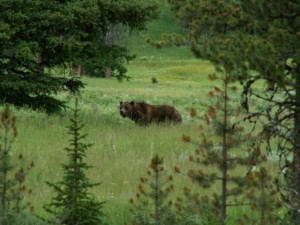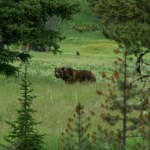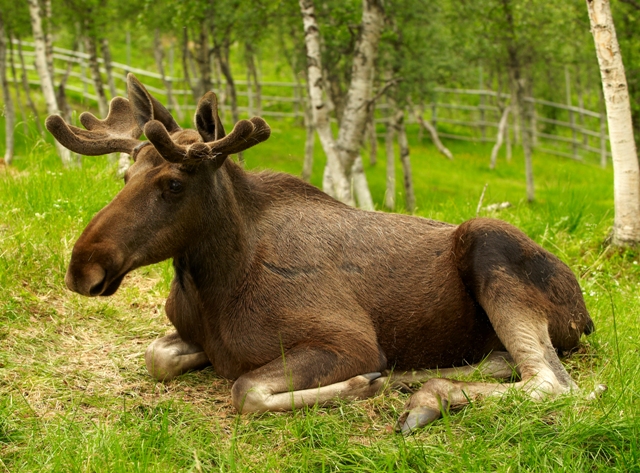January 9
Bigfoot – Alaska SightingsAnother surprise was how there seemed to be no reports from the North Slope area, where the drilling companies are. One would expect at least one or two. There would be no lack of food, with large caribou herds, seals, and other fuzzies running around.
Other areas of note would be the Tok area, 15 in all, mostly around the river near the highway, including a recent grouping near Border City, 7 in all, of tracks between 2003 – 2013. Hydaburg had 5 reports between 1994 – 2004. The river area around Bethel had 7 reports from 1999 – 2012. Denali Park entrance area had 5 from 1992 – 2010. Another surprise was that there were no current reports from my neck of the woods in Alaska. One would think with the concentration of people would result in a number of reports with the higher percentange chance of interaction.
The points of reports posed an interesting question because one would think that there would be more reports in the outlying areas of the larger cities: Anchorage, Mat-Su, Fairbanks, Juneau, and there weren’t. However, the other reports weren’t isolated and in the middle of the woods, either. The reports were your typical “crossing the road,” “saw at the beach,” “saw on a trail” type reports in areas where there were towns and cabins. Hopefully, as word gets out, more people will report sightings, and with a great site just for Alaskans, like sasquatchtracker.com, more data can be gained.


February 16
Bigfoot – To Call or not to CallMany Bigfoot researchers believe that these animals communicate by calls and knocking. Just as hunters use calls to bring their prey closer, researchers have tried to bring in the creatures by filling the air with calls. However, some of the calls I have seen done on TV sound very similar to other animals found in the areas of investigations. There is also the possibility of contamination in the results by pranksters hiding in the woods and answering back. One particular call, used by Finding Bigfoot researchers sounds too similar to the high, sometimes shrieking, calls of the coyote.
Here’s a link from Finding Bigfoot where the investigators are Making Calls at Night. You can hear them talking about hearing coyote calls, and then another sound that they think is not a coyote. However, when they imitate the sound, it sounds just like a coyote call.
They also make grunting noises as another type of call. Unfortunately, the grunting noises sound similar to a number of animals, including bears and wolverines. Here is a bear cub calling for its mother, sounds like the grunt calls they do: Bear Cub Grunting.
Here’s a coyote barking and howling. Now I’ve personally heard them do this high-pitched howl longer (about 3 secs) without any barks or change in pitch Short Coyote Howl
The point here is that care should be taken to analyze calls heard in the wild. Just because a person has never heard anything like it before, does not mean it is not a known animal. The best method to attract a bigfoot would be to use recorded calls played back in the woods. The reason that recorded sounds are normally banned from hunting activities is because they can be extremely effective. Recordings also eliminate the inaccuracy of a human voice replicating a call and ensure all the fine nuances of a call are replicated.
Check out other recent posts on Bigfoot:
[postlist 1]
Don’t forget to look up new posts and theories on Bigfoot by clicking on the Bigfoot Category from the top left link.


February 13
Bigfoot – Why not more Alaskan Research? When researchers discuss Bigfoot sightings, they almost exclusively talk about the northwestern United States, Washington and Oregon area. I wondered why there was not more talk about Alaska, a place with over 650,000 square miles and vast wilderness doesn’t have more Bigfoot sightings? Perhaps it is because of the uniqueness of way of life in Alaska that offsets the ability to have Bigfoot sightings. You see, in Alaska, people are used to living in areas with large animals. Alaska is home to the largest bear population in the United States, and is home to the largest of the deer family, the moose. Wildlife, as is common knowledge, is plentiful here. As such, Alaskans are especially careful when going out into the wilderness. In bear country, we make sure to make plenty of noise by singing, talking loudly, and clapping. This bear safety basic is to help alert any bears in the area, “Hey bear, here comes a human, get out-of-the-way.” Bears are often shy creatures and will move when hearing people come. With Bigfoot an even shyier creature and more stealthy, they would have no problem avoiding an encounter.
When researchers discuss Bigfoot sightings, they almost exclusively talk about the northwestern United States, Washington and Oregon area. I wondered why there was not more talk about Alaska, a place with over 650,000 square miles and vast wilderness doesn’t have more Bigfoot sightings? Perhaps it is because of the uniqueness of way of life in Alaska that offsets the ability to have Bigfoot sightings. You see, in Alaska, people are used to living in areas with large animals. Alaska is home to the largest bear population in the United States, and is home to the largest of the deer family, the moose. Wildlife, as is common knowledge, is plentiful here. As such, Alaskans are especially careful when going out into the wilderness. In bear country, we make sure to make plenty of noise by singing, talking loudly, and clapping. This bear safety basic is to help alert any bears in the area, “Hey bear, here comes a human, get out-of-the-way.” Bears are often shy creatures and will move when hearing people come. With Bigfoot an even shyier creature and more stealthy, they would have no problem avoiding an encounter.
Imagine if an Alaskan did see a Bigfoot. Unless they were in feet of it, they would probably just dismiss it as a bear. Many Alaskans believe that Bigfoot sightings in Washington and Oregon are just misidentified bears. Since we see bears so often, we might find it hard to believe something we see was anything but a bear.
Coyotes and wolves are also very plentiful in Alaska. Coyote cries are often heard even near towns. When I watch the Finding Bigfoot show, I believe they are misidentified coyotes cries, which can sound like someone screaming or wailing, and not the typical howl. Of course, if an Alaskan hears a cry or howl in the woods, we would be more apt to believe it was a bear, wolf, or coyote before thinking it was a Bigfoot.
Perspective plays a large part in Bigfoot research. If you live in an area in which you don’t believe there is a lot of wildlife out there, you might be more apt to believe something strange was Bigfoot. However, if you live in an area where you frequently see wildlife, then you might be more apt to believe something strange you saw was a normal animal and not a Bigfoot. An Alaskan camping in the woods and hearing something rustle around their tent, or seeing a big shadow hover over their tent will probably think it is a bear. But what if it was really a Bigfoot. Alaskans often know that bear tracks often over lap. But what if a track wasn’t an overlapped bear print. My point is that I believe more research teams need to come to Alaska. Hike out to the wilderness, off the beaten path, and research the dense wilderness here. If researchers talk to local hunters more, and ask them to record and photograph anything odd they find, more Alaskans might realize that what they are hearing, and seeing, just might not be the usual animals. In theory, what if Alaskans have misidentified Bigfoot?
Check out other recent posts on Bigfoot:
[postlist 1]
Don’t forget to look up new posts and theories on Bigfoot by clicking on the Bigfoot Category from the top left link.


January 30
Bigfoot Investigative Do’s & Don’tsAs shows on Bigfoot have grown in popularity, common sense seems to have lessened in proportion. Here are some Do’s and Don’ts that should be considered on investigations.
DON’T have a town meeting before investigating. A town meeting is a good way to gather eyewitness reports, HOWEVER, this announces your presence in the area and gives hoaxers plenty of time to set up in wooded areas discussed at the public meeting. With this in mind any evidence of calls, knocks, rock throwing, heat signatures, twisted branches or other human capable evidence HAS to be thrown out. Unless of course a bigfoot is actually FILMED doing the act. If a team wants to hold a town meeting, the result should be to find new locations to search, or to confirm other stories. There are a plethora of stories out there, sneak into town quietly and do a night or two of research in reported areas BEFORE announcing your presence. Yes, there can still be hoaxers out in the woods, but at least the chance of contamination can be lessened.
DON’T assume calls and knocks are Bigfoot. Unfortunately, bigfoot calls can and do sound like other animals found in the areas of investigations. A high pitched cry can be a coyote. A low grunt can be a bear or wolverine. Knocks could be two trees smacking together in the wind. Of course, any of these sounds could also be pranksters messing with you. Nothing throws me into fits faster than when a researchers hollers into the woods, they hear a call back, and instantly they say, “There’s a Squatch in these woods.” How the heck do they know it’s a Squatch? Fire Truck sirens can set off dogs howling. It could just be another animal responding to the noise. Record the evidence, and then get it analyzed by a professional in the animal calls for the area being researched.
DO look up. I watched an episode recently where several eyewitnesses mentioned that the Bigfoot was able to jump high and in fact had been seen high up in trees. Yet, not once did the investigation show the “scientists” looking up into the trees with their own eyes, night vision, or thermal cameras.
DO believe in the fact that Bigfoot is a high intelligent species. Whether Bigfoot is related more to humans, or to apes, the fact remains that they would be highly intelligent. Researchers are counting on the fact that Bigfoot has a complicated vocal system of calls and knocking to communicate across great distances. Do they really think a Bigfoot is going to hear them stumbling and crashing through the woods and simply continue to walk nonchalantly in front of their camera lens? This intelligent creature is probably well practiced in hiding and being discreet. Many of the eyewitness reports state that they often were hiding behind trees, etc. Think like they would, and figure out what would be a great hiding place, or where would they go if someone came crashing through this trail. Be a step ahead, and maybe you can catch sight of them.
Check out additional Posts on Bigfoot below:
[postlist 1]
Don’t forget to look up new posts and theories on Bigfoot by clicking on the Bigfoot Category from the top left link.


January 30
Bigfoot – Bears, Moose, and UnicornsI then proposed a 2 part theory to her. The first was whether she believed that Bigfoot ever interacted with bears? Ranae replied that it was possible since, Bigfoot were believed to live in the same type of forested areas.
With that confirmation, from a “scientist”, I then proposed that if Bigfoot and bears lived in the same area, and Bigfoot were believed to be extremely territorial and aggressive at times, even killing deer, that could it be possible for Bigfoot and bears to fight each other? Since bears were known to even fight to the death with each other, is it possible that a bear might kill a Bigfoot, or vice versa? What if a Bigfoot was killed, and a hunter stumbled upon the kill and mistook that “bear kill” to simply be a moose kill?
Ranae’s response was, “the question is, would the moose be mistaken for a unicorn?” She then scolded me that I “theorized incessantly” and science was done by going out into the field and not making up theories while sitting at home. Of course, I was infuriated, and wondered if Einstein, who sat at a patent desk all day, theorizing about quantum physics, would agree.
You see, my theory was that a moose is a huge animal, with a huge rib cage. Bigfoot is supposed to be a huge animal, with by description a huge rib cage. When an animal is killed, after the main predator has their fill, other predatory animals come in and take what pieces they can carry away. That is why old kills often do not have all the pieces together in the same area. An entire carcass is hardly ever found whole, and all together. It is often scattered through out the area. So, my theory was that a hunter might stumble upon a carcass, and simply chock it up to be a moose kill from a bear, when in fact it could be a dead Bigfoot, whether by natural causes, or even a bear. My point to presenting this to Ranae was that her group, that was actually out investigating should examine and take in the evidence found by hunters. Maybe even invite hunters to report kills found, so that they could be investigated and confirmed as to what animal it was, and what animal killed it. Even if the body wasn’t a Bigfoot, maybe a Bigfoot killed it and thus DNA and hair might be left behind on the carcass. Proof from a carcass would be solid evidence of Bigfoot, and change the direction investigations were done. Instead of simply going out into the woods and waiting for noises, and wondering if they were pranksters or not. This method could provide the solid evidence needed.
The one thing I can thank Ranae for is her utter disregard to discussing other people’s theories and her belief that just because I don’t have the capability or funding to go out and do research, that my ideas were not even worth contemplating. I was infuriated that she so flippantly pushed me aside and openly mocked me, that she inspired me to create a place where others like me can discuss our theories openly.
In case you want to side with Ranae that only people who can investigate should theorize, then I suggest you talk to NASA who takes hypothesis from students and has the astronauts on the space station implement the experiments.
Check out additional Posts on Bigfoot below:
[postlist 1]
Don’t forget to look up new posts and theories on Bigfoot by clicking on the Bigfoot Category from the top left link.


January 26
The Why and the What For?I consider myself to be a simple but intelligent person. I believe that curiosity is the key to living, and that if you stopped being curious what would be the point to life? I have an interest in cryptozoology, paranormal and the mysteries of the universe. As the number of shows in these genres have grown, my disappoint in the investigation techniques grew, too. Some shows, like Destination Truth, perform excellent and detailed investigations. Other shows, like Finding Bigfoot, lack greatly in the use of scientific method.
It is due in part to the Finding Bigfoot show, that I have chosen to create this site. Thru Twitter, I proposed several theories to the “scientist” of the team on ways to find evidence. The “scientist” responded rudely and labeled me as theorizing incessantly (details will be posted on the Bigfoot page). How could a scientist, who by definition needs to create a theory according to scientific method, say that someone theorized too much? Many theories in the scientific world cannot be field researched immediately. Sometimes, the person with the theory does not have the means to conduct the investigation. This was the reason I had proposed my theories to this “scientist” who was actively investigating Bigfoot. I proposed my theories to spur them onto a new thought pattern, a new lead for investigation. Instead, I was dismissed as simply being an armchair quarterback that didn’t know what I was talking about because I had never gone out to look for bigfoot. With the realization that there may be others like myself, I created this site for the dismissed and thrown aside to discuss intelligently about different subjects in our universe. I created a place for people “To Theorize Incessantly.”






